
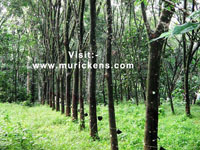
Commercially, natural rubber is obtained almost exclusively from Hevea brasiliensis, a tree indigenous to South America, where it grows wild to a height of 34 meters(120 feet). Cultivated in plantations, however, the tree grows only to about 24 meters (80 feet) because carbon, necessary for growth, is also an essential constituent of rubber. Since only atmospheric carbon dioxide can supply carbon to the plant, the element has to be rationed between the two needs when the tree is in active production. Also, with foliage limited to the top of the tree (to facilitate tapping), the intake of carbon dioxide is less than in a wild tree. Other trees, shrubs, and herbaceous plants produce rubber, but, because none of them compares for efficiency with Hevea brasiliensis, industry botanists have concentrated their efforts exclusively on this species.
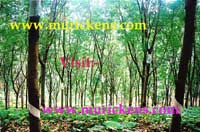
In the cultivation of Hevea, the natural contours of the land are followed, and the trees are protected from wind. Cover crops planted adjacent to the rubber trees hold rainwater on sloping ground and help to fertilize the soil by fixing atmospheric nitrogen. Standard horticultural techniques, such as nursery growing of hardy rootstocks and grafting on top of them, hand pollination, and vegetative propagation (cloning) to produce a genetically uniform product, are also employed.Hevea grows only within a well-defined area of the tropics and subtropics where frost is never encountered. Heavy annual rainfall of about 2,500 millimetres (100 inches) is essential, with emphasis on a wet spring. As a consequence of these requirements, growing areas are limited. Southeast Asia is particularly well situated for rubber culture; so too are parts of South Asia and West Africa. Cultivation ofHe vea in Brazil, its native habitat, was virtually destroyed by blight early in the 20th century.
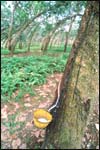
When the bark of the Hevea tree is partially cut through (tapped), a milky liquid exudes from the wound and dries to yield a rubbery film. The biological function of this latex is still obscure: it may help wound-healing by protecting the inner bark, or it may serve other biochemical functions. The latex consists of an aqueous suspension of small particles, about 0.5 micrometer in diameter, of cis-polyisoprene, a linear rubbery polymer of high molecular weight. The rubber content of the suspension is about 30 percent.
Rubber trees are tapped about once every two days, yielding a cupful of latex, containing approximately100 grams of solid rubber ,under the favorable conditions of the environment by a healthy hybrid RRII-105 adult plant /tree. The standard method of tapping is to score the tree with a knife for half the circumference of the trunk, slanting the cut down from left to right at an angle of 30° starting at the highest point convenient to the tapper. Each subsequent cut is made immediately below its predecessor. Trees are often rested for a period after heavy tapping. Production commences when a tree is 5 or 6 years old; with care, the tree's useful life may extend to more than 20 years. With trees cultivated at a density of 375 to 450 per hectare (150 to 200 per acre), approximately from hybrid verity rubber 3,500 to 4,500 kilograms of rubber can be produced per hectare per year (that is, approximately ).
After collection of the tapped latex, rubber is recovered from emulsion by coagulation with formic acid, creating crumbs that resemble curds of milk. The crumbs are washed, dried between rolls, and compacted into blocks 67 by 33 by 18 centimeters (26 by 13 by 7.5 inches) in size and weighing 33.3 kilograms (73 pounds). The blocks are then wrapped in polyethylene sheets and packed into one-ton crates for shipping. Other productions as smoked sheet, where the coagulum is pressed into thin sheets that are washed and then dried over a smoky wood fire . The smoke contains natural fungicides that protect against mold growth and impart a characteristic amber colour. Dried sheets are packed into 110-kilogram (250-pound) bales for shipping.About 10 percent of all natural rubber is shipped as latex, concentrated by centrifugation to a rubber content of approximately 60 percent and used for making dipped goods such as surgical gloves, prophylactics, and toys.
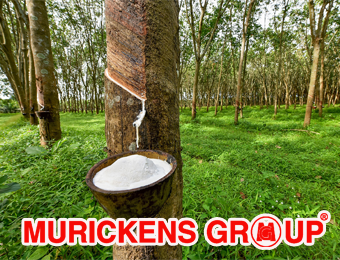
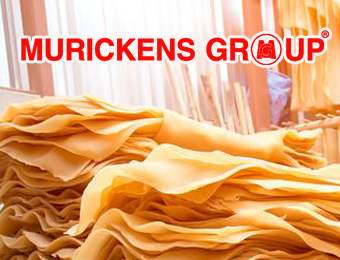

MURICKENS GROUP
HO : KOTTAYAM-KADUTHURUTHY
BR : KOTTAYAM- CEMENT JUNCTION
ERNAKULAM-PALARIVATTAM
Real estate cunsulting officials at U.S.A. (Texas & Newyork) & Bombay
Email : mg@murickens.com, murickans@gmail.com